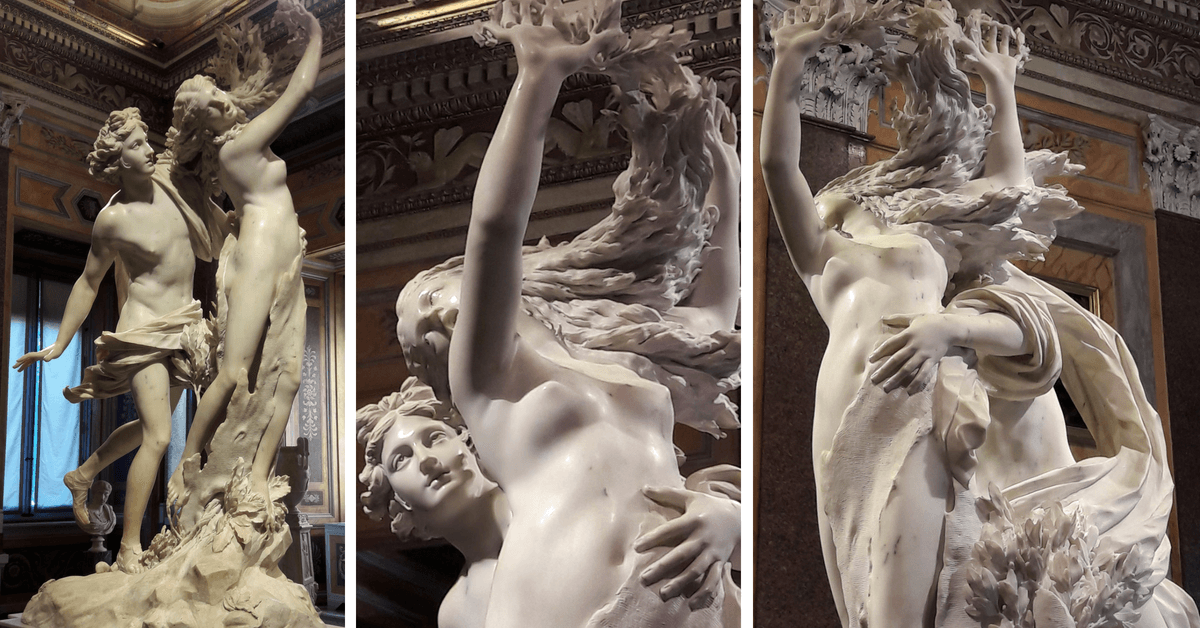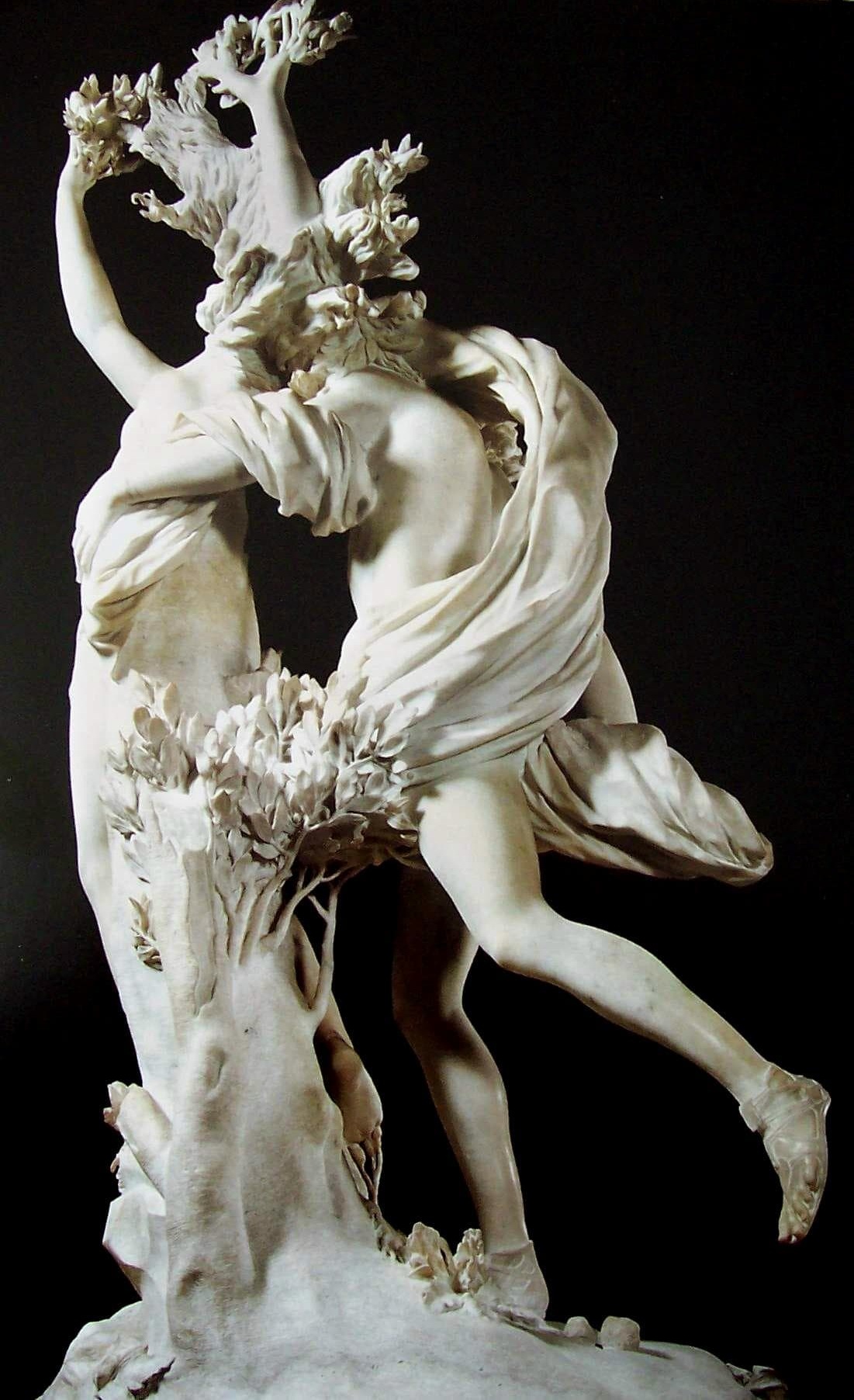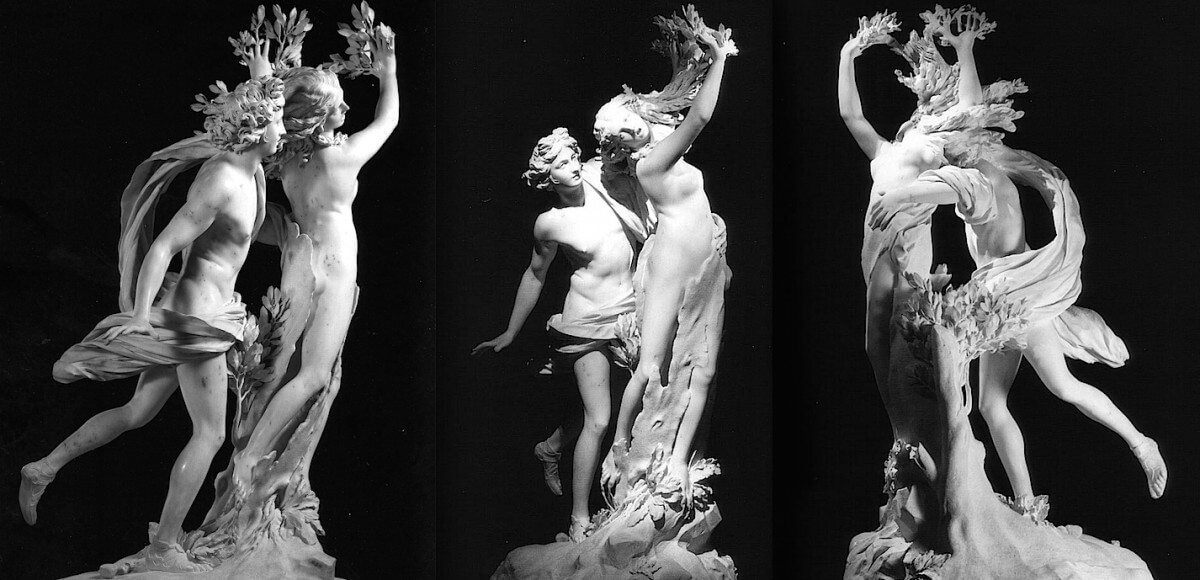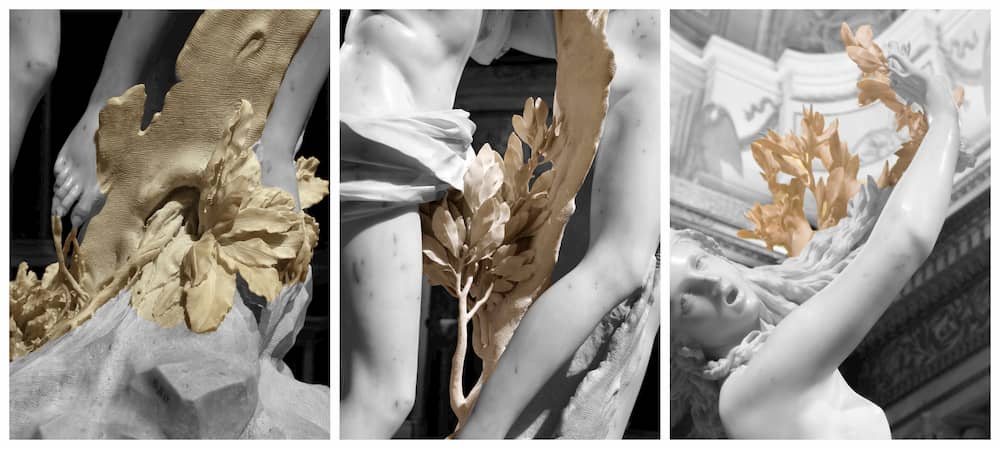The subject was not new in the history of art, but sculptors had never tackled it. With Bernini's Apollo and Daphne, the artist dared to do what until then seemed impossible: to represent in marble a human body that is transformed into a plant.

Bernini's Apollo and Daphne
Apollo pursues Daphne because he is in love with her. The nymph, on the other hand, does not correspond to the wish of the god. Then she runs away to the river and her father Peneus transforms her into a laurel plant. Apollo has reached Daphne and is about to grab the nymph. The god is naked and covered with a tight cloth around his right shoulder and her hip. His hair is long and sways elegantly in the wind.
Apollo grabs Daphne with his right hand. With his left hand, however, the god balances himself while he runs. Apollo wears shoes on his feet. The god stands on his right leg while his left leans back. His lips are parted and panting from the rush and lust. The two bodies brush but do not touch.
Daphne runs to escape Apollo. The nymph arches her body to gain some advantage over the god. Dafne is naked and her body is transforming. In fact, her feet turn into roots. The nymph tries to lift her right foot already stuck to the ground. The bark wraps around her body and her hands rise to the sky turning into leaves. The nymph's face has a frightened expression and her mouth is wide open with fear and running. Her cloak, which is falling off, billows in the wind. She is confused and gasping.
In a moment the transformation will be complete, the hard bark will completely cover her beautiful woman's body, the arms and hair, already partially changed, will be fronds. Numerous painters and sculptors of the XNUMXth century tried to amaze the viewer, but none succeeded as much as Bernini, who in fact became an indisputable master, an obligatory reference for generations of artists.
The work, whose figures are to real scale, is conceived to offer many different points of view. Bernini wanted to position it so that upon entering the room one could initially see only Apollo from behind and guess at the crescendo of Daphne's metamorphosis. In fact, from that angle you could see the bark that already covers the body of the nymph but also the hand of the god that, according to Ovid's verses, still felt her heart beating under the wood. Only by walking around the sculpture would the details of the transformation be discovered.
Interpretation of Apollo and Daphne by Bernini
A cartouche, placed at the base, shows a phrase in Latin by Maffeo Barberini, the future Pope Paul V: "Whoever loves to pursue joys in the fugitive way, turns his hand to the branches to reap fruits, instead he reaps bitterness". Therefore, this writing demonstrates how the mythological subject is used to express a moral concept: Daphne, transformed into a bush to escape the persecution of Apollo, becomes a symbol of virtue; at the same time, the group of sculptures wants to warn not to stop only at earthly beauties.
We read in the Metamorphoses: “He still prays, that a deep numbness invades his limbs, his soft chest is wrapped in fine fibers, his hair spreads out in leaves, his arms in branches; the feet, once so fast, get stuck in lazy roots, the face vanishes in a hair: it only preserves its splendor”.
The style of the statue
Bernini's Apollo and Daphne is one of the most representative results of all Baroque sculpture: dynamic attitudes; torsion of bodies; gestural and physiognomic expressiveness; marble surface gloss; circular and multiple vision of the work; sentimental and spatial implication of the work.
The statues sculpted by Gian Lorenzo Bernini express movement thanks to their dynamic postures. Apollo and Daphne run forward and their expressions are intense. Apollo's muscles stand out to represent the exertion of running. Instead, Daphne's body is smooth and graceful. The surface of the marble is sculpted in different ways. Tosco to represent the bark. Perfectly smooth to make the skin of the two protagonists.
With Bernini's Apollo and Daphne (and the other sculptures by Scipione Borghese) he reached the highest and most complete expression of the representation of movement. He was only able to fix one moment of the action, the crucial one. In fact, his figures no longer represent a fact but the occurrence of that fact, no longer a reality but the transformation of that reality. Apollo and Daphne get caught up in the race, at the exact moment when the young woman transforms into a tree: a moment before she was still a woman, a moment later she would no longer be.
The two young men are in a precarious balance, they seem unbalanced, they seem to have to fall at any moment. Apollo has his left leg stretched backwards (the only point of support on the ground is still his right leg). Daphne, on the other hand, is literally lifted by the roots that sprout from her feet. In fact, the representation of the movement is situated in the two arches described by the figures that are intertwined with the ideal spiral formed by the trunk, the mantle and the arms.
Bernini competes with Ovid, and both are winners, because if it is true that poetry is the master of time while figurative art is the master of space, it is also true that the Neapolitan sculptor subverts this state of affairs, taking advantage of the power of movement.
In Bernini's Apollo and Daphne, the meticulous treatment of marble, from the detailed representation of the foliage and the layers raised by the wind to the bark of the trunk, from the loose hair of the protagonists to the bewildered and surprised look of Daphne, contributes to capturing perfectly the action that unfolds before the watchful eye of the observer.
Overall, Bernini's Apollo and Daphne certainly represents one of the most successful moments in Baroque sculpture due to its workmanship and palpable psychological strain. Bernini's dexterity, in fact, offers a sculpture that does not have a privileged point of view, but gives the viewer the opportunity to capture in every detail the classic beauty, typical of Hellenistic art, and at the same time the sensuality and richness of the details, typical of baroque poetics.
compositional structure
Bernini's statue of Apollo and Daphne is very balanced. In fact, some parts expand in space while others contract. Also, the lines of force create two curves. One runs the length of Apollo's body. The second coincides with the arc drawn by Dafne's body. Bernini has created a set of ways in which space creates voids that make the sculpture light. The two figures are projected upwards as if they were floating.
Bernini knew how to solve the complex problem of the relationship between thrusts and counter-thrusts through a highly refined balance game: the bodies, legs and arms of the two figures extend out into space, defying the laws of gravity, but always somehow balanced by other parts that extend in the opposite direction.
Bernini also knew how to take the question of marble to its extreme possibilities of expression. The artist's was a continuous bet with the static limits of the material, a challenge that seemed to ignore the fragility of marble and that pushed him to the increasingly daring search for positions and turns to the limit of their due, of ideas, devices, camouflages, made it possible to defy the force of gravity.
Such a result can only be obtained thanks to extraordinary technical control. And it is no coincidence that Bernini was an excellent technician, celebrated for his incredible skills. Bernini's Apollo and Daphne, in particular, seems like a true miracle of technology.
The two figures are obtained from a single huge block and the sheets reach minimum thicknesses, so much so that they could break with the simple pressure of the fingers. The artist was also masterful in depicting the silkiness of Daphne's bare skin contrasting with the roughness of her new bark. All this generates amazement and admiration.
Franco Borsi, one of the most important scholars of the Italian Baroque, wrote:
“The foundations of an aesthetics of wonder are not specific to Bernini's world in any circumscribed sense […] but they are certainly widespread in the cultural world in which Bernini moves, attentive and instinctively determined to capture the voices on which to sing. then his search for consensus”
The myth of Apollo and Daphne in the metamorphoses
The myth of Apollo and the nymph Daphne tells that the god Apollo, son of Zeus, boasting of knowing how to use the bow and arrows like no other, incurs the wrath of Cupid. The latter, to punish the young god's pride, hits him with an arrow that falls in love with the beautiful nymph Daphne (whose name means "laurel" in Greek), daughter of the river god Peneus and Gaia, the Earth.
However, Daphne consecrated her life to the sister of Apollo, the goddess Artemis, dedicated to chastity and the maintenance of virginity, values of which she is so supportive that she forces the nymphs of her entourage to follow her example, under penalty of exemplary punishment.
Apollo, in love, desperately tries to reach his beloved Daphne, who asks her father for help to protect her innocence. Peneus therefore, to prevent the two young men from uniting, makes sure that the daughter's human form dissolves at the touch of the god. Apollo, in fact, pursues Daphne until, reaching out and touching her, he sees her transform into a laurel (the laurel wreath is one of the symbols of the god Apollo).
other aspects
Bernini's sculpture of Apollo and Daphne was commissioned from Bernini by Cardinal Scipione Caffarelli Borghese. It was also the last request that the famous collector made to the artist. The sculptor began the work very young, barely twenty-two years old, in 1622. He was then forced to interrupt the work in the summer of 1623.
First he had to finish El David commissioned by Cardinal Alessandro Pedretti. Bernini thus resumed the execution of Apollo and Daphne in 1624 with the help of the sculptor Giuliano Finelli, who took care of the roots and leaves. In 1625 the sculpture was finished and immediately met with great success.
The artist
Thanks to the extroverted genius of Gian Lorenzo Bernini (1598-1680, he is universally considered the most important artist of the European XNUMXth century: sculptor, architect, painter, stage designer, urban planner, he always reached, and in all fields, levels of absolute excellence.
In 1615, when he was only seventeen years old, he was already a brilliant professional who worked, together with his father Pietro, a sculptor like him, at the service of the reigning Pope, Paul V, of Cardinal Maffeo Barberini, future Pope Urban VIII, and above all of Scipione Borghese (1576-1633). Scipione, nephew of the pontiff, was one of the most powerful men in Rome. A great patron and former supporter of Caravaggio, he distinguished himself by his extraordinary culture and irrepressible passion for collecting.
Cardinal Borghese himself offered the young Bernini the first great opportunity of his career: the four sculptural groups that would make him famous as an artist. These works, commissioned by Scipione in 1618 for his Villa Borghese, and known as the Borghese Gallery, enriched the Cardinal's already famous art collection (which boasted the beautiful Caravaggio) and are still in Rome today in the Borghese Gallery. They are Aeneas, Anchises and Ascanius, the kidnapping of Proserpina, Apollo and Daphne and David.
Gian Lorenzo Bernini was born in Naples in 1598, his mother was Neapolitan, his father Pietro Bernini is a sculptor, he works in Naples, Florence and Rome. Pietro moved to Rome with his family in 1605, and Gian Lorenzo spent most of his life in Rome, except for a long stay in Paris in 1665, called by King Louis XIV. In Rome, his career took place in a long series of successes, and Bernini was in charge of the most important companies as a sculptor, set designer and architect, especially for the popes that have followed one another in the fifty years of his activity.
The Roman art scene in this period is dominated by Gian Lorenzo, before him only Michelangelo was held in such high regard by popes, intellectuals and artists. There are many similarities with Michelangelo: even Bernini considers sculpture his great passion, since he was little he was in a family where marble was worked and it became his favorite material. Like Michelangelo, he is a complete artist: he is a painter, sculptor, architect, poet, set designer and in front of each work he knows how to dedicate himself with great concentration and deep participation to the work.
Drawing represents for him a fundamental means of all his creative activity, through which he writes down every impression, idea and solution from brief sketches to the most precise projects and funny caricatures. The extraordinary talent and creativity with which he tackles any task is also undeniable. The differences with Michelangelo concern rather the human and social sphere: Bernini is a very sociable, ingenious and brilliant man, dedicated to the family and a skilful organizer.
In 1611 Gian Lorenzo found himself an assistant to his father Pietro Bernini, who was working on the reliefs for the Chapel of Paul V in Santa Maria Maggiore in Rome. This occasion marks the beginning of his career and also of his fortune, since during the work he was warned by the Pope and Cardinal Scipione Borghese, who entrusted him with the decoration of his villa. Nineteen-year-old Bernini creates a series of mythological groups and statues executed between 1619 and 1624, which are still in the Villa Borghese in Rome. He remained in the cardinal's service until 1624.
With the election of Pope Urban VIII Barberini, Bernini, still very young, became a leader in the artistic life of Rome and held this position throughout his life, devoting himself above all to religious works. After the death of Carlo Maderno, in 1629 Gian Lorenzo was appointed "architect of San Pietro".
In his youth, in the early XNUMXs, his work was in great demand as a portrait painter, but with the increase in monumental commissions, Bernini no longer had time to devote himself to portraiture. Already at the end of the twenties and in the following decade to fulfill all the commitments he had to hire assistants and the portraits made in a mature age are less numerous than the works of greater commitment such as statues, tombs, chapels, fountains, squares, churches, built during the pontificates of Urban VIII, Innocent X and Alexander VII.
Even painting is mainly concentrated in the twenties, later he preferred to dedicate himself to sculpture, while most of the architectural undertakings belong above all to the last stage of his career, corresponding to the period of Alexander VII. Bernini died in Rome in 1680.
Here are some links of interest:





